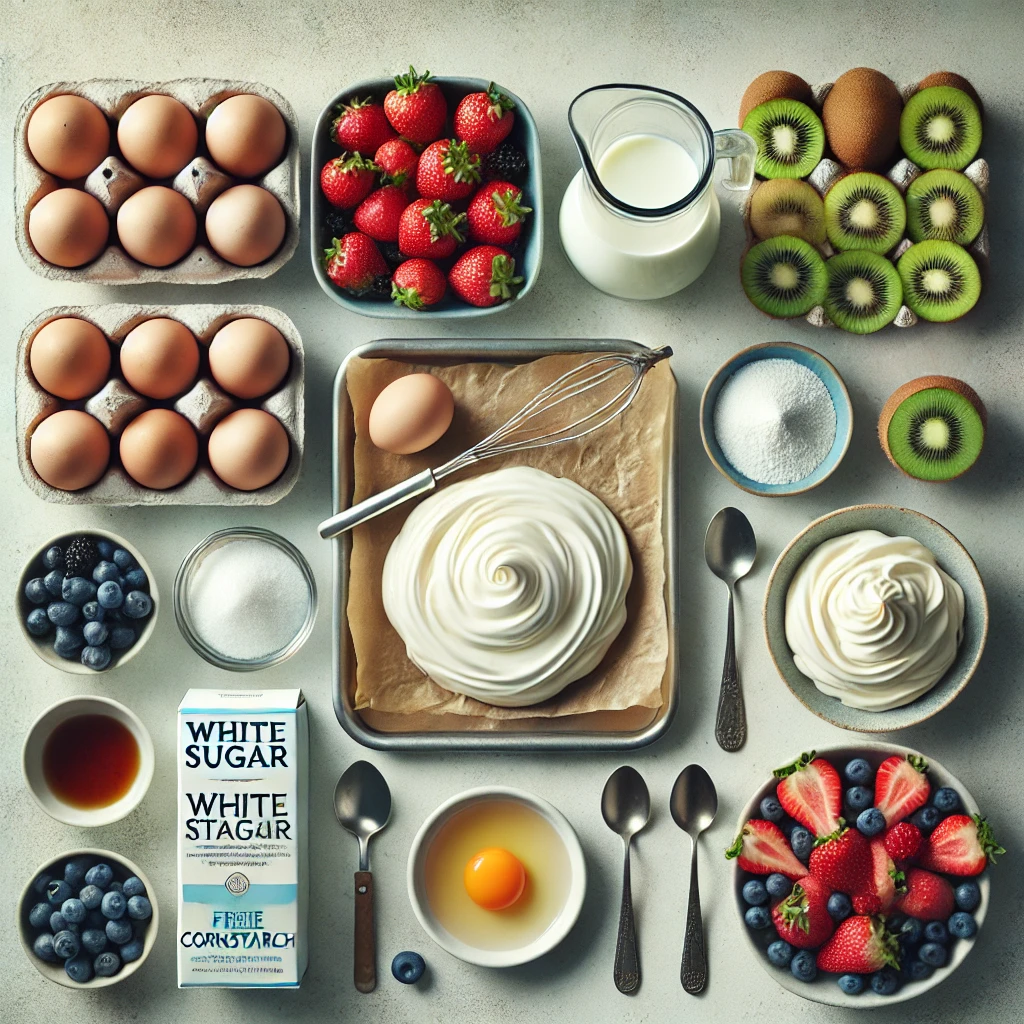Perfect Homemade Pavlova Recipe: A Step-by-Step Guide to Fluffy Meringue Bliss
Pavlova, a light and airy meringue-based dessert, has become a favorite across the globe for its cloud-like texture and versatility. Although Pavlova originated in Australia and New Zealand in honor of the famous Russian ballerina Anna Pavlova, it has won the hearts of dessert lovers worldwide, including the USA. In this guide, we’ll take you through each step, ensuring you can create this stunning dessert in your own kitchen.

Ingredients for the Perfect Pavlova
Essential Ingredients for a Flawless Pavlova
To make an elegant, light Pavlova, you only need a handful of ingredients. Here’s a list with measurements for convenience:
- 4 large egg whites (room temperature)
- 1 cup granulated sugar (fine or caster sugar works best)
- 1 teaspoon white vinegar (adds stability to the meringue)
- 1 tablespoon cornstarch (keeps the center marshmallows)
- 1 teaspoon vanilla extract (optional, for extra flavor)
- Toppings: Fresh whipped cream, seasonal fruits (such as strawberries, kiwi, blueberries), and optional passion fruit or berry drizzle.

Note: For the fluffiest meringue, use room-temperature eggs, as this makes the whites easier to whip. This tip is essential in ensuring the perfect texture.
Step-by-Step Guide to Making Pavlova
Step-by-Step Instructions for Homemade Pavlova Bliss
Let’s dive into each step of making Pavlova, focusing on precision, patience, and technique to ensure a successful bake.
Preparing the Ingredients
- Separate the egg whites: Carefully separate the egg whites from the yolks. Ensure no yolk contaminates the whites, as even a small amount of fat can prevent them from whipping properly.
- Prepare the sugar: Use superfine (caster) sugar for best results, as it dissolves more easily into the egg whites, resulting in a smoother texture.
Tip: Use a clean, grease-free bowl to whip the egg whites. Metal or glass is preferred, as plastic can hold grease, which disrupts the meringue.
Whipping the Egg Whites
- Begin whisking on low speed until the egg whites start to foam.
- Gradually increase the speed to medium-high. When you reach soft peaks, begin adding sugar slowly—about a tablespoon at a time—until the meringue reaches stiff peaks.
- Check for dissolved sugar by rubbing a small amount of the meringue between your fingers. It should feel smooth, without any gritty sugar particles.
Quote: “The key to a perfect meringue is patience and gradual mixing. The slower the process, the fluffier the result.”
Adding the Cornstarch and Vinegar
- Gently fold in the cornstarch and vinegar. These ingredients help create that iconic soft, marshmallows center in the Pavlova.
- Optional: Add vanilla extract at this point if you’d like a hint of flavor.
Shaping the Meringue on the Baking Sheet
- Line a baking sheet with parchment paper and trace an 8-inch circle as a guide.
- Spoon the meringue onto the circle, using a spatula to shape the edges and create a small dip in the center. This dip will hold your whipped cream and fruit toppings after baking.
Pro Tip: Shape with care. A smooth, rounded shape will help the Pavlova bake evenly and look elegant once finished.
Baking the Pavlova
- Preheat your oven to 250°F (120°C). A low temperature ensures the meringue dries out gradually without browning.
- Place the meringue in the center of the oven and bake for 1.5 hours.
- Once done, turn off the oven but leave the Pavlova inside with the door slightly ajar for another hour to cool completely.
Why this is essential: Gradual cooling helps prevent cracks and keeps the outside crisp while maintaining the soft, fluffy center.
- YouTube Video: Ready to perfect your Pavlova Recipe skills? Watch this step-by-step video for tips on achieving that perfect crispy shell and marshmallow center
Pro Tips for the Perfect Pavlova
Expert Tips for a Fluffy and Beautiful Pavlova
Here are some expert insights to help you master Pavlova-making:
- Use fine sugar: Superfine or caster sugar dissolves more easily, ensuring a smooth texture.
- Avoid humidity: Humidity can cause meringue to weep, so it’s best to bake on a dry day.
- Slowly add sugar: Incorporating sugar slowly into the egg whites is essential for stable peaks.
- Cool gradually: Letting the Pavlova cool in the oven prevents cracks and ensures the texture remains light and fluffy.
Key Takeaways
- Bold Takeaway Points for quick insights:
- Gradual whisking leads to a stable, fluffy meringue.
- Low baking temperatures create the ideal texture without browning.
- Proper cooling prevents cracking and ensures an airy, cloud-like dessert.
FAQ: Common Questions About Making Pavlova
- What fruit works best on Pavlova?
Fresh fruits like berries, kiwi, mango, and passion fruit add refreshing flavor and color contrast. - Why does my Pavlova crack?
Cracking often occurs due to temperature changes or humidity. Gradual cooling minimizes the risk. - How long can Pavlova be stored?
The meringue base can be stored in an airtight container at room temperature for up to 2 days, but toppings should only be added just before serving. - Can I make mini Pavlovas with this recipe?
Yes! Simply spoon smaller mounds of meringue onto the baking sheet and reduce the baking time to about 45 minutes.
Conclusion
Wrapping Up: Enjoy Your Perfect Homemade Pavlova!
With the right techniques and a bit of patience, you’ll be rewarded with a beautiful, cloud-like dessert that’s sure to impress. Whether it’s for a holiday gathering, a special occasion, or simply a treat for yourself, homemade Pavlova is worth every step.
Link to similar recipes like [Canada’s Top 5 Healthy Breakfast recipes] to engage dessert enthusiasts with other cultural recipes.
You want to take your baking skills to the next level? Check out America’s Test Kitchen for professional guidance on achieving perfect meringues and beyond. Direct readers to America’s Test Kitchen for more in-depth baking tips and meringue mastery.









1 comment